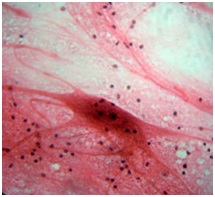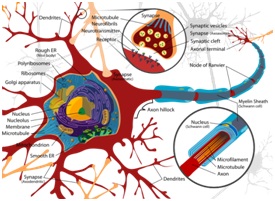![]() Soft Tissue Associated Wave Phenomena with Application to Brain Injury
Soft Tissue Associated Wave Phenomena with Application to Brain Injury
PI: Prof Bala Balachandran
Biomaterials are usually classified as hard tissues (bone, wood) and soft tissues (skin, muscles, organs). Brain tissue is characterized as a soft tissue and it is composed of what is called nerve tissue, that is to say, a network of neurons or nerve cells. The figures below show two images of nerve tissue in which structures can be clearly discerned. These structures are neurons, which are composed of a relatively large body, with multiple extensions called dendrites, and a single elongated extension (rod-like) structure called axon. Other smaller cells that act as a support for the neurons are the glial cells (whose nuclei can be observed as black spots).
This work investigates wave propagation in soft tissue in order to carry out the following: i) understand the influence of soft tissue nonlinear material properties on its mechanical response when subjected to transient loading and ii) characterize the mechanical response of soft tissue with respect to the frequency and amplitude of the applied loading.

Nerve Tissue

Neuron Detail with Myelinated Axon
The linear analysis is used to study the effects of blast waves on the internal structure of the human brain. Axons can be thought of as rod-like structures whose lengths in the brain range from 10 mm to 170 mm, or even shorter. By using this analysis, the frequency bound for propagation of waves through axons of different lengths can be obtained.
This linear analysis has allowed us to understand wave characteristics such as wave speed and attenuation. Further studies were conducted via numerical solutions of the nonlinear problem. One unique nonlinear phenomenon that can be of potential importance, and that cannot be predicted by linear analyses is the steepening of wave fronts, leading to abrupt changes in stress as the wave travels; this behavior resembles features associated with shock waves.
We conclude that the rod model for brain fibers allows us to understand the importance of nonlinear material properties and the importance of considering the nonlinear nature of these properties, especially, for blast load related problems. It is also noted that the transient response of the nonlinear material is highly influenced by the amplitude of the load, the frequency components of the load and the dissipation of the soft tissue. Therefore, accurate determination of the material properties of soft tissue is crucial in developing models that can accurately capture transient nonlinear effects.

